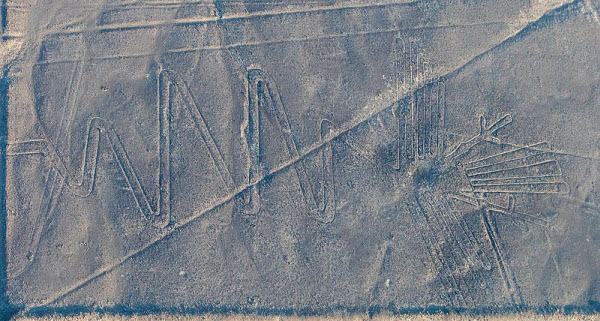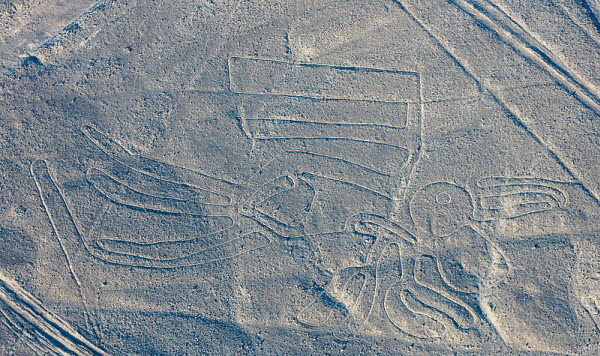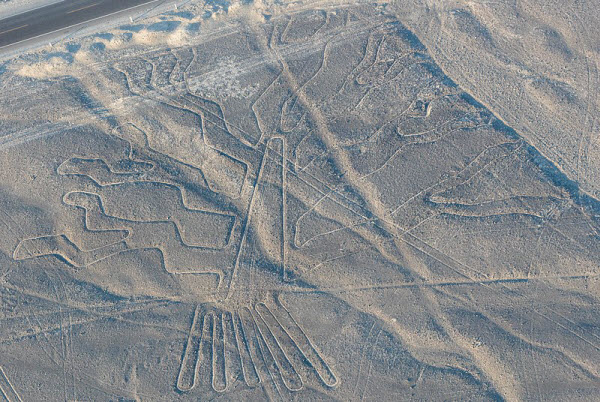Located over 400 kilometers south of Lima, the capital of Peru, in a desolate area not far from the Pacific coast, lies a vast and barren site known for one of the world’s oldest mysteries: the Nazca Lines. These enormous geoglyphs stretch across extensive flatlands, formed by a series of long trenches, some reaching up to 40 kilometers, with shallow depths not exceeding 30 centimeters. The lines create shapes visible only from great heights, including depictions of animals, reptiles, and large parallel lines forming enigmatic symbols. Despite their discovery in the mid-20th century, the true nature of these lines remains unclear. Whether they are messages from ancient civilizations or creations of extraterrestrial beings is still debated.
The first travelers who encountered the Nazca Lines in the 16th century believed they were remnants of vast and complex roads from a bygone civilization. However, the truth wasn’t revealed until 1927, when Peruvian archaeologist Toribio Mejía Xesspe was ascending a nearby series of hills. Looking down, he saw the trenches and lines clearly and realized they were not ancient roadways but rather vast, intricate images carved into the earth. These massive designs were not recognizable from ground level, leading both archaeologists and enthusiastic amateurs to strive to understand and interpret one of the world’s greatest mysteries.

Given the astonishing scale and complexity of the Nazca Lines, it is not surprising that supernatural explanations have emerged. Proponents of paranormal theories argue that it is unlikely the indigenous people could have created such designs around 2000 years ago without the ability to fly, which would have been exceedingly difficult at the time. Consequently, they suggest that extraterrestrial beings might have been responsible. Others claim that the lines were created spontaneously but with instructions from beyond Earth, perhaps to serve as landing strips for spacecraft or to attract the attention of such beings with large images visible from space. Supporters of the alien theory point to peculiar shapes in the Nazca Lines that resemble natural forms, such as humans, insects, birds, fish, trees, and flowers, including the famous “Astronaut” design, which depicts a human figure with an inflated head resembling an astronaut in a spacesuit.

One of the most notable proponents of these theories was Swiss author Erich von Däniken, who was convinced that some of the biological forms in the Nazca Lines depicted extraterrestrials. This idea was popularized in his 1968 book “Chariots of the Gods,” which sparked interest among conspiracy theorists. This fascination was further fueled by the discovery of several mummies in the region, believed to date from between 100 BC and 800 AD. These mummies were expertly embalmed, and archaeologists found well-preserved bodies, sometimes in unusual conditions. What intrigued them most was the unusual elongation of some skulls. In 2017, a mysterious mummy with three fingers was discovered in the area, leading enthusiastic researchers to speculate that it might not be human at all.

While these are the views of those who believe in supernatural explanations, scientists refute the idea that extraterrestrial beings were involved in creating the Nazca Lines. They argue that even if extraterrestrial visitors existed, there is little reason to believe they were behind this specific mystery. Unlike the pyramids, which raise long-standing questions about their construction by the ancient Egyptians due to their complex and challenging engineering, the Nazca Lines could have been created easily with the available human technology of the time. The lines were simply created by scraping away the top layer of rocky soil, which had turned a dark reddish-brown over thousands of years, revealing the lighter yellow sand beneath. The resulting color contrast created distinct lines visible for miles. Creating accurate designs would have been straightforward by first constructing small models and then using ropes and stakes—some of which have already been found—to scale them up.

Although the Nazca Lines are more visible from an airplane window, they are fully visible from elevated ground, such as the surrounding hills, as first seen by the Peruvian archaeologist. The creators could have easily guided the process by observing from the nearby hills. The longevity of the designs is also easily explained by the region’s extremely dry climate. With minimal rainfall—averaging 4 millimeters per year—and minimal wind disturbances, the trenches carved thousands of years ago have remained almost unchanged. Thus, there is no need for extraterrestrial involvement either during their creation or afterward. The so-called “Astronaut” figure is also known as the “Giant,” and it is not hard to imagine that its creators intended to depict themselves with slightly enlarged skulls, as seen in the extracted mummies. As for the widely believed three-fingered mummy, many consider it a hoax, and the large skulls have been identified by archaeologists as a common practice called artificial cranial deformation. This involves binding the skulls of infants while they are still flexible to create a modified shape that persists into adulthood. This practice was widely used among ancient peoples worldwide and is thought to have been used as a group marker to differentiate tribes from outsiders or as a sign of social status within the tribe. Despite its oddity, it is believed to have had little impact on the health of the individuals involved.

Although the method of creating the Nazca Lines in Peru is clear, the purpose of their creation remains a mystery. Archaeologists speculate that they may have had astronomical significance. Paul Kosok and Maria Reiche, early researchers of the Nazca Lines, hypothesized that the lines were markers for celestial events, such as sunrise and moonrise. However, recent scholars have questioned these astronomical interpretations, noting that most lines do not easily correlate with celestial events. Johan Reinhard believes that the lines were likely markers for ritual sites, particularly those related to water. In such a dry climate, water would have been a constant concern for the area’s inhabitants. Some archaeologists see representations of spiders in the Nazca Lines as symbolic of rain, with other animals like monkeys and hummingbirds representing regions with abundant water.

To this day, the reason behind the construction of the Nazca Lines remains elusive. However, researchers hope that with new technology, especially high-tech drones like those used by Peruvian archaeologists to discover 50 new lines in 2018, answers about the Nazca Lines may soon be within reach.
